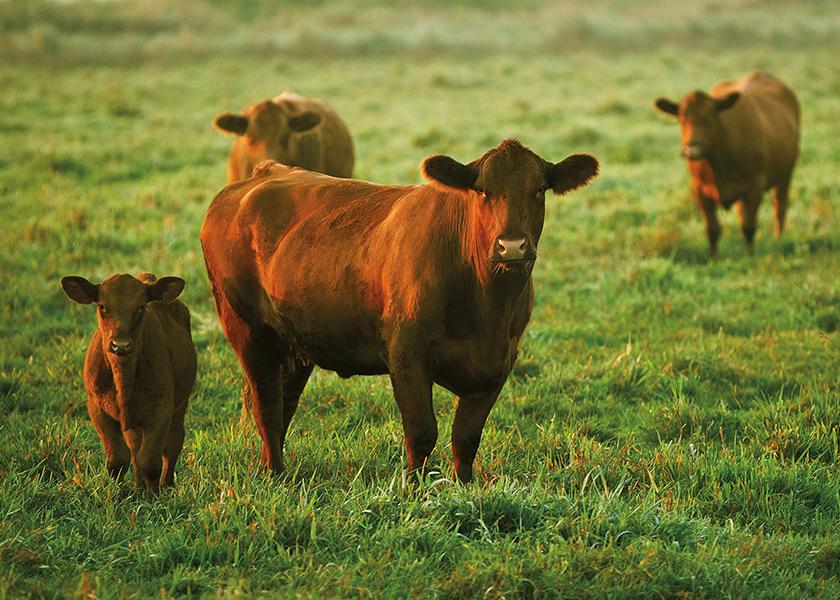After Drought, Managing Calf and Cow Health is Critical

The effects of drought conditions on the cow herd can extend beyond the cow to the newborn calves, especially if they’re born into wet conditions, said Jess Hinrichs, DVM, with Zoetis beef technical services, and based in Sutton, Nebraska.
“It comes down to cows with poor body condition scores. It’s well documented that cows with poor body condition will have poor-quality colostrum, and that we get less colostral transfer to those calves,” Dr. Hinrichs said. “After a drought, these cows have been impacted and haven’t gained any body condition. Their calves are going to get less immunity through their colostrum than they would in a normal year. The calves are going to be more susceptible to early life or neonatal health challenges if we don’t have that foundation of immunity that we typically get from colostrum.”
As far as disease challenges facing these immunosuppressed calves, the main ones are scours (neonatal diarrhea) and respiratory disease.
“We’re going to be dealing with conditions at calving that are much wetter than we’ve expected and more favorable for stress and pathogen exposure,” Dr. Hinrichs said.
Scours tends to be more of a management disease, so reducing pathogen exposure and increasing the comfort for those calves is a good start to helping the calves get through the period of greatest risk.
If possible, he recommends employing a “Sandhills” style calving system which includes some rotation throughout the calving period with expecting cows removed to a fresh pasture and leaving cow/calf pairs behind.
Other practices that can help include giving cow/calf pairs more space, providing ample bedding and/or a sheltered area that calves can access. These areas need to be cleaned out and re-bedded on a routine schedule so they don’t become heavily contaminated.
For respiratory conditions, Dr. Hinrichs recommends focusing more on colostrum management and potentially supplementation, whether with actual colostrum from within the herd or from some of the commercial colostrum supplements on the market. “This might be a good year to try to manage colostrum better and provide extra supplementation for those calves,” he said.
He notes increasing the use of intranasal vaccines, such as Inforce 3®, early in life helps provide respiratory protection without maternal antibody interference sometimes seen with injectable respiratory vaccines.
Dr. Hinrichs also recommends giving calves a respiratory vaccine just before they’re turned out on grass. For cow/calf producers, respiratory disease is a large component of calf losses, so providing a boost with another vaccination at branding or turnout can help limit those losses. At turnout or branding, the two-month-old calf’s immune system is more mature than it was at a week of age, so there is going to be a stronger immune response to that vaccine, providing protection into the summer months.
These later vaccinations also help prime the calves for the next round of vaccines at preconditioning or weaning, Dr. Hinrichs said. If the immune system is primed from a branding vaccination for respiratory disease, there is a two-fold benefit from those vaccines: (1) calves are better protected while on grass, and (2) calves are set up for a quicker and higher level of protection at weaning.
With the calves set up for a strong start, it is also time to support the cow as she prepares for the breeding season. “The biggest thing we can do to help that cow is supporting her nutritionally. We’ve got to be heavily focused on rations and make sure we’re providing her with everything she needs,” Dr. Hinrichs said.
This means working with a nutritionist to make sure rations are meeting nutritional needs to get the cow herd into at least a maintenance state or better yet gaining body condition heading into breeding season. Micronutrients – vitamins and minerals – should not be neglected at this time, he said, as deficiencies are often seen after a drought and drought-stressed forages may have the same deficiencies. It may be more important to test forages this year as they may not contain the expected nutrient levels.
While the nutritional side of cattle management is important in the gestation period, producers should not neglect their vaccination programs either, Dr. Hinrichs said. “We want to do everything we can do to protect those fetuses because fetal losses can add up, and fetuses may be more fragile this year than other years due to the drought.”
For more herd health information, visit BuildingHealthyHerds.com.







